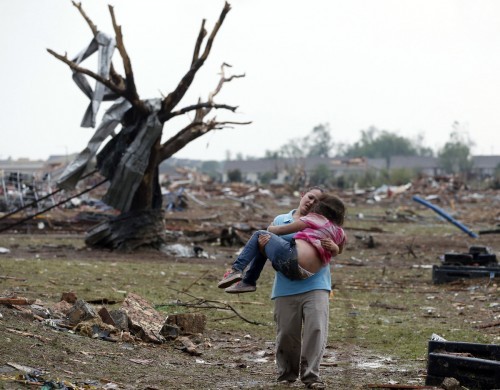On Monday, May 20th, an Oklahoma tornado crashed through suburbs, leveling entire neighborhoods, setting buildings on fire and landing a direct blow to an elementary school. In the photo* above, a woman carries her child through a field near the collapsed Plaza Towers Elementary School in Moore, Oklahoma on Monday, May 20, 2013. How much more heartbreaking does it get?
In the aftermath of the Oklahoma tornado tragedy if you’re wondering how to talk to children about tragedy and natural disasters, you’re not alone. It’s totally normal to be bamboozled by such catastrophe. The key, however, is including children in the dialogue.
Many of you already know how important it is to me that adults talk with children and keep lines of communication open. Silence is NOT golden especially when television and other media are depicting graphic scenes of devastation. Children are being exposed to stories and photos of dislocated families, destroyed homes and a rising death toll. UGH. We MUST talk with children about natural disasters.
The thing of it is: when children are left alone with information, they have the capacity to imagine far worse than reality (even when reality is awful!). For example, young children often confuse facts with fantasy and may not realize that the same images are shown over and over again on television. Rather they may think that the disasters are happening over and over again. Yup. How awful is that?
The Silver Lining here is that there are concrete tools for talking with and helping children cope with the tornado in Oklahoma and other tragedies:
- Encourage ongoing dialogue. The more communication the better. One conversation is not enough. Children are better able to take in and cope with small amounts of information at a time.
- Be honest. Use developmentally appropriate words and concepts that children can understand.
- Encourage children to ask questions. Make sure that you listen to the questions being asked and and concerns being expressed. Don’t assume and please don’t project your fears onto your children. Answer the questions that children ask. Keep it to that. Do not volunteer more information than asked because children may not be ready to handle that information. Unconsciously, they know what they can handle and when.
- Know the facts. Be able to explain what a natural disaster is as well as how and why they happen. Use simple, clear facts and avoid opinions.
- Normalize feelings – especially fear. It is important that a child not be left with distressing feelings. A child may demonstrate their distressing feelings by throwing temper tantrums, an inability to sleep or having meltdowns. Pay attention to unusual behavior and address behaviors head-on.
- Turn OFF the television. Watching the devastation over and over and over again only heightens a child’s worry and fear. Research has shown that watching media coverage, especially repeated viewing, can create stress for children even when they are not directly exposed to disaster. Television viewing for young children needs to be limited. If they see some television that reports on disaster, it is best for parents to watch with their children in order to deal with their reactions and correct misinformation.
- Reassure children that they will be taken care of and that you will do everything that you can do to protect them. DO NOT tell them that “this will never happen to you” because as we know all too well, a natural disaster can happen anytime, anywhere.
- Use the conversation as an opportunity for learning. Talk about what you and your family would do in the event of a natural disaster. Make a plan. The reassurance will provide comfort.
- Encourage children to relax. Some options include: coloring, reading poetry, singing songs.
- Maintain a consistent routine because children equate a routine with stability and security.
The important thing to know is that children take their coping cues from us, the trusted adults in their lives. This isn’t to say that we should cover our emotions. Not at all. Rather, we need to model healthy coping mechanisms for our children. Some examples include:
- Talking
- Moderating news intake
- Self care (eating, sleeping, bathing)
- Express our feelings
Including children in the dialogue about a natural disaster is a Silver Lining amidst the tragedy because it demonstrates that parents are trustworthy and that honesty is a core family value.
Resources:
- The American Academy of Pediatrics
- Book: A Terrible Thing Happened by Margaret M. Holmes
* Photo credit: Sue Ogrocki




1 comment